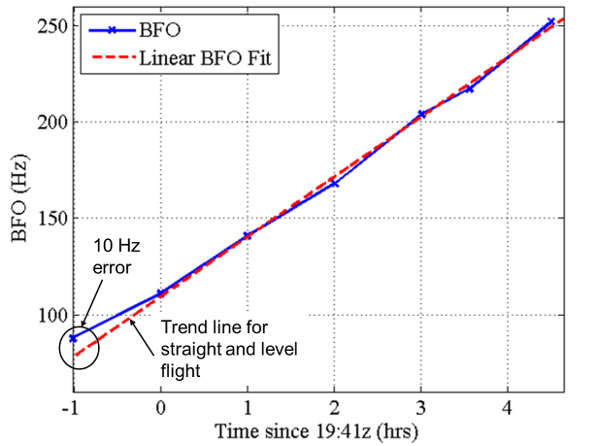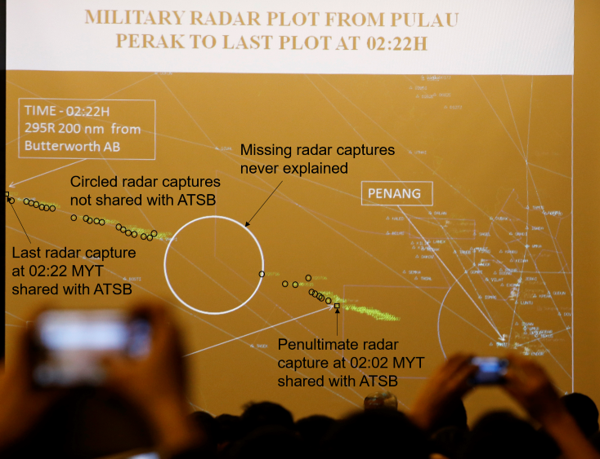MH370’s SATCOM initiated a log-on to Inmarsat’s I3F1 satellite at 18:25:27, and after some exchange of data, completed that log-on at 18:28:15. (All times are UTC). The log-on process provides us with additional BTO and BFO data points which can help us to understand what the path and speed of the plane was at this time. Many of us have long assumed that the plane’s track just before the log-on was 296°T and the groundspeed was around 495 kn for two reasons:
- These values are consistent with the position and timing data that we extracted from the often-discussed Lido Hotel radar slide, which was presented to the NOK in Beijing on March 21, 2014. The slide shows radar captures of an unknown target (suspected to be MH370) up until 18:22 along the N571 airway traveling at about 495 kn.
- This combination of speed (495 kn) and track (296°T) matches the first and last BFO values (142-144 Hz) surprisingly well.
However, there are two problems with this theory:
- Between the initial and final values of around 143 Hz, the BFO peaks at 273 Hz and decays to intermediate values of around 174 Hz before returning to 144 Hz.
- If we assume the last recorded radar position at 18:22 is correct, then the BTO values during the log-on don’t match a plane traveling at a constant 495 kn along N571.
Back in July of 2015, some of us proposed an explanation that reconciled the radar, BTO, and BFO data: Soon after MH370’s SATCOM requested the 18:25 log-on to Inmarsat’s I3F1 satellite, the pilot initiated a 12-NM lateral offset manoeuver to the right of airway N571. (A pilot flying a leg of a route can program a lateral offset of a specified distance and the offset manoeuver will be automatically performed and the offset automatically maintained.) If the offset was timed just right, i.e., initiated just after 18:25:27 and completed just before 18:28:06, the BTO data matches, and all but the peak BFO value of 273 Hz can be explained. Most of us attributed this unexplained peak in frequency to a SATCOM anomaly that was not disclosed by its manufacturer (Honeywell Thales). With nothing better, we chose to ignore it.
We have gained more knowledge now that Ian Holland published his paper that discusses BFO behavior of a SATCOM as it logs-on to a satellite after it has been previously de-powered. Dr. Holland’s analysis suggests that the BFO sequence observed at 18:25 was not caused by a turn sequence taking place during the log-on. Rather, the BFO sequence is consistent with a SATCOM that has been de-powered for some time, warms-up, and logs-on to a satellite. As the oscillator crystal in the Satellite Data Unit (SDU) approaches it operating temperature, there is a peak in frequency followed by a decay to its final value. (Some like Mike Exner, Henrik Rydberg, and others have long suspected this.) So now the unexplained peak of 273 Hz is explained and verified as repeatable.
Although the warm-up transient adequately explains the BFO sequence at the 18:25 log-on, it still doesn’t explain the BTO sequence, which is not consistent with a path along N571 at 495 kn between 18:25:27 and 18:28:15 that includes the recorded radar position at 18:22.
We have some additional clues from the report on MH370 released in December 2015 by Australia’s Defense Science and Technology Group (DSTG). As part of the investigation of MH370’s disappearance, Malaysia supplied the ATSB with the raw radar data up until the last capture at 18:22:22 with a 10-second spacing. However, no radar data was supplied between 18:01:49 and 18:22:22, and no explanation was provided for the 20-minute gap. If we are to believe there were no radar captures in this period, we should also question the validity of the data shown in the Lido Hotel radar image. This in turn calls into question whether MH370 was following airway N571 at the time of and subsequent to the final radar capture.
If we remove the constraint that MH370 was following airway N571, we can consider other candidate paths using the following methodology:
- The path of MH370 that was captured by radar can be approximated by starting at a known position before 17:21 and integrating the groundspeed and track data provided graphically in the DSTG report. (Despite numerous requests, Malaysia refuses to release the actual radar data.)
- Starting at the radar-derived position at 18:02 and lasting through the 18:25 log-on, we assume that MH370 proceeded along a great circle path towards a selected waypoint at constant ground speed. The effect of variations in wind and temperature are ignored for now. (In fact, the temperature variation is small and the groundspeed differs from the true airspeed by at most several knots, which is within the margin of error of this analysis.) Several candidate waypoints are considered, each producing a different initial track at 18:02.
- For each initial track, a speed is determined by minimizing the RMS error of the BTO values at times 18:27:04 through 18:28:15 where the expected standard deviation is 29 μs. For the BTO at 18:25:27, the expected standard deviation is higher at 62 μs and was not used.
- For the BFO, only the BFO value at 18:28:15 is considered, as the prior values are distorted by the warm-up transient, as advised by Dr. Holland.
The candidate paths are shown in the figure above, and the results from the analysis are shown in table below. The paths fan outwards from the recorded radar position at 18:02. It can be seen in the figure that as the initial track rotates towards the north, the path length required to reach the 18:28 arc increases, which translates to higher speeds, and also higher BFOs. Therefore, not all of these paths satisfy speed and BFO criteria. A discussion of the candidate paths follows.

Case 1. Path towards the last radar point at 18:22 that minimizes BTO error
This is the baseline case considered in the DSTG report as the initial track of the path connecting the 18:02 and 18:22 radar positions is close to the observed radar track at 18:02 (around 289°T). The BTO error is minimized at a groundspeed of 459 kn, requiring a reduction in speed of about 59 kn, which is possible. (A pilot could choose to decelerate by climbing or using spoilers, which would drastically reduce the time to reach the new speed.) The BFO error at this speed is 6 Hz, which is acceptable by most measures. However, the distance and timing between the two radar points requires a minimum speed of around 499 kn, which would mean that the 18:22 radar point was in error by about 14 NM. So, considering this error and the absence of acknowledged radar data between 18:02 and 18:22, there is justification to completely ignore this last radar point, just as the DSTG chose to do in its analysis. Therefore, in the remaining cases analyzed, the last radar point at 18:22 is ignored, and we accept the 18:02 radar point as the last recorded position. Ignoring the last radar point doesn’t invalidate this path. It just makes it less special.
Of course, if we ignore the last radar capture, it once again begs the question that Malaysia refuses to answer: What data was actually shown to the NOK at the Lido Hotel in Beijing on March 21, 2014?
Cases 2,3,4,5. Paths towards airports that minimize BTO error
Recognizing that the radar data suggests that MH370 flew near (but not exactly over) Kota Bharu and later Penang Airports, we consider the possibility that after passing Penang, the plane was flown towards another airport in the region. We consider candidate paths towards Port Blair, Car Nicobar, Sabang, and Banda Aceh Airports, and for each path, find the speed that minimizes the BTO errors. As can be seen in the table, only the path towards Car Nicobar has an acceptable BFO error (3 Hz) and an acceptable speed (518 kn). This speed is consistent with what was observed by radar around 18:02. It’s also very fast compared to typical cruise conditions, corresponding to (no-wind conditions) of about Mach = 0.87 at FL350 at a temperature offset from standard conditions of around +10K. Although this Mach number is within the performance limitations of the plane, if MH370 flew along this path, it has important implications on the achievable endurance and range.
Case 6. Path that minimizes BTO error and exactly matches BFO
For this case, we allowed both the track angle and speed to vary as the BTO error was minimized and the BFO at 18:28:15 was constrained to match exactly. The calculated groundspeed is 499 kn, which is closer to a more typical speed that maximizes fuel efficiency. The path crosses the 18:28 arc about 33 NM to the north of the ATSB’s baseline path towards the 18:22 radar point.
Summary
The radar data presented to the NOK at the Lido Hotel in Beijing on March 21, 2014, has been used by independent investigators to justify a path along airway N571. Recognizing that the radar data has never been officially acknowledged by Malaysia, and also recognizing that the radar data from that image was never provided to the ATSB by Malaysia, we have to question its validity. Strangely, the final radar point at 18:22 from that image was provided to the ATSB, despite the 20-minute gap between it and the proceeding capture at 18:02. By choosing to ignore this final radar point, MH370 is much less likely to have followed N571, and other candidate paths along great circles can be found that satisfy the BFO and BTO data at the 18:25 log-on. The path that arguably best satisfies the satellite data crosses the 18:28 arc 33 NM to the north of the path that includes the 18:22 radar point. There is also an acceptable path that leads to Car Nicobar Airport, which requires a speed about the same as was observed before radar coverage was lost at 18:02.
Update on 2/22/2017: Incorporated some small edits based on private comments from Mike Exner.





